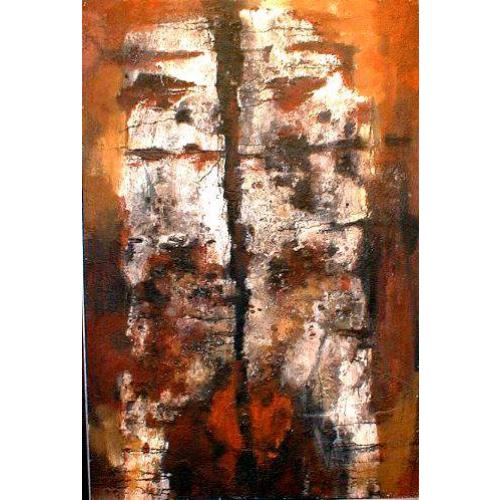Probably Phyllida Hodgkinson, the artist’s then second wife, following their separation in 1970 – and probably sold by her to a private collector;
Cambi Casa D'Aste, Milan, Italy, 18/12/20, lot 84.

Click image to zoom
Frank Hodgkinson
A Garden of Earthly Delights, 1964 - 1965
mixed media on board, triptych
130.00 x 300.00
each panel signed and inscribed on reverse “Frank Hodgkinson / Galilea 64 / A Garden of Earthly Delights, 1965 / Triptych” - see note below.
Frank Hodgkinson - Paintings and Collages, Hamilton Galleries, London, 20 January - 6 February, 1965, no. 2
Frank Hodgkinson - Paintings and Collages, exhibition catalogue, Hamilton Galleries, London, 1965, no. 2, illus. across the centrefold in b&w; in the catalogue listing none of the other works are titled - they are simply listed descriptively 'Painting', 'Gouache' etc.;
Barry Pearce, Morris West and Lou Klepac, Frank Hodgkinson, The Beagle Press, Sydney, 1994, see plates 55, 56 and 57, for other works in the series;
and Christie's, Impressionist and Modern Australian Paintings, Drawings, Prints and Sculpture, London, 30/11/1989, see lot 158 for a related diptych of the same series (this series was presumably painted over two to three years as the dates are somewhat contradictory - the work was not numbered, and catalogued as mixed media on canvas laid down on panel, diptych, signed, inscribed and dated '64 on one panel, '65 on another and '66 on the third, 132 x 102 cm)
Of all the Australian expatriates in the 1960s few could rival Frank Hodgkinson’s acceptance into the contemporary art world of their host country. In a manner similar to John Peter Russell’s full embrace of French Impressionism, Hodgkinson immersed himself deeply in the texture painting that, in Spain, was the most distinctive field of exploration. By 1960 he was being classed as a Spanish artist in both local and touring exhibitions (Klepac, op. cit. p. 136) and in 1964 he held a solo show at El Prado del Ateneo in Madrid. At the invitation of the Ministry of Culture and under their curatorial guidance (and with VIP invitations already sent to the British and Australian Ambassadors) all seemed well till the day before the opening when several major works were removed by the censor. (Carlos Antonio Arean, art critic, in Klepac, op. cit. p. 155)
Whilst in Madrid it’s clear he would have been impressed by that extraordinary collection of works by Hieronymus Bosch in The Prado, assembled by the most ascetic of kings, Philip II. Bosch’s The Garden of Earthly Delights, 1503-15 is probably the centre piece of that collection and inspired the present suite of acrylics employing some potentially risqué collage. (Klepac, op. cit. plates 56 & 57) Hence, one assumes, their exhibition the following year in London rather than in Spain. This triptych is the major work in the series which, to use a river analogy, can be seen as a billabong or anabranch. Given they bear no relation to the overall landscape tradition which forms the main stream of his oeuvre, it’s temping to feel they form a riposte to the censors.
An unusual detail: each panel is backed with newspaper, mostly from Italy and one partly from England.
Further works by the Artist
Since its establishment in 1984, the Charles Nodrum Gallery’s exhibition program embraces a diversity of media and styles - from painting, sculpture & works on paper to graphics and photography; from figurative, geometric, gestural, surrealist & social comment to installation & conceptually based work.
























